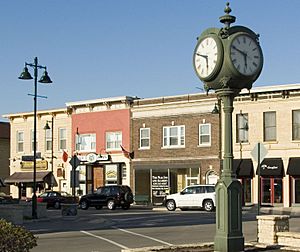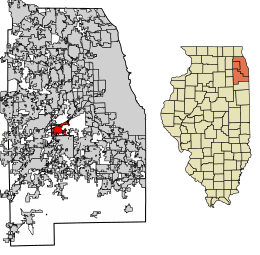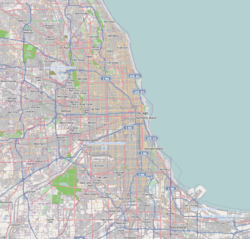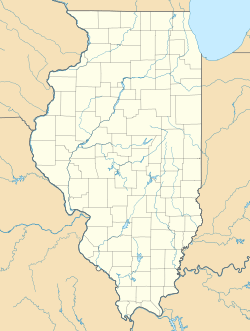Lemont, Illinois facts for kids
Quick facts for kids
Lemont, Illinois
|
||
|---|---|---|

Budnik Plaza clock and Stephen Street facades in historic downtown Lemont
|
||
|
||
| Etymology: From French for "The Mount" | ||
| Motto(s):
Village of Faith, Enjoy Our Scene!
|
||

Location of Lemont in DuPage County, Illinois
|
||
| Country | United States | |
| State | Illinois | |
| County | Cook, Will, and DuPage | |
| Township | Lemont, Downers Grove, DuPage, Homer | |
| Settled | 1836 | |
| Incorporated | June 9, 1873 | |
| Area | ||
| • Total | 8.74 sq mi (22.64 km2) | |
| • Land | 8.37 sq mi (21.67 km2) | |
| • Water | 0.38 sq mi (0.97 km2) | |
| Population
(2020)
|
||
| • Total | 17,629 | |
| • Density | 2,107.47/sq mi (813.70/km2) | |
| Time zone | UTC-6 (CST) | |
| • Summer (DST) | UTC-5 (CDT) | |
| ZIP Code(s) |
60439, 60490
|
|
| Area codes | 630/331 | |
| FIPS code | 17-42795 | |
| Wikimedia Commons | Lemont, Illinois | |
Lemont is a village in Illinois, located southwest of Chicago. It spans parts of Cook, DuPage, and Will counties. In 2020, about 17,629 people lived here. The village is built on a hillside next to the Des Plaines River. It's known for being home to Argonne National Laboratory and having a diverse community.
Contents
Lemont's History
Early Days and Name Changes
Before European settlers arrived, Native Americans like the Potawatomi lived in the Lemont area. They used the Des Plaines River for trade and relied on nature for everything they needed. In the 1700s, French traders called voyageurs also traveled the river, trading with the Native Americans.
Lemont had a few different names in its early days. It was first called Keepataw, after a Potawatomi chief. Then it was known as Athens and later Palmyra. In 1850, it finally got the name Lemont, which means 'the mountain' in French.
Building the Canals
Lemont was settled in 1836, making it one of the oldest towns in northeastern Illinois. It played a big part in turning this area from a wild frontier into a busy place for trade and industry. The village has a special historic downtown that has been used since the 1800s. In 2016, this historic area was added to the National Register of Historic Places.
A very important part of Lemont's history is the Illinois and Michigan Canal (I&M Canal). Building this canal started in 1837. When it was finished in 1848, it created a continuous water route from New York all the way to the Gulf of Mexico. This canal connected the Great Lakes to the Mississippi River.
Many Irish immigrants came to Lemont to work on the canal. After the canal was built, they often settled in the towns along its path, helping them grow.
The Limestone Industry
While digging the canal, workers found a special type of stone called Lemont yellow dolomite. This stone was harder and finer than regular limestone. This discovery led to Lemont's second major industry: quarrying. By the mid-1800s, quarrying limestone became the main way people made a living in Lemont.
Many important buildings in Lemont were built using this local stone. Today, 38 of these buildings still stand in the downtown area. Lemont limestone was even used to build the Chicago Water Tower. This building became famous because it was one of the few structures to survive the Great Chicago Fire of 1871. In the past, this stone was sometimes called "Athens Marble".
The I&M Canal was used for transporting goods and people until the early 1900s. Then, a bigger canal, the Chicago Sanitary and Ship Canal, was built next to it. The Sanitary Canal is still used today as part of the Illinois Waterway system.
Lemont's motto is "Village of Faith." The many church spires in the town show the different groups of immigrants who came here to work in the quarries and other industries.
Lemont and the Civil War
Lemont is known for being a major recruiting spot for the Union Army during the American Civil War. The Old Stone Church, built in 1861 from limestone, was used as a place to sign up soldiers. This church served as the Lemont Methodist Episcopal Church for 100 years. Since 1970, it has been home to the Lemont Area Historical Society and now serves as a museum. It is also listed on the National Register of Historic Places.
Lemont was asked to provide 33 soldiers for the Civil War, but the village actually recruited 293! Sadly, only 63 of them returned home. A memorial was built in Legion Park in 2008 to honor these brave soldiers. One of them, Cpl. John Warden, was the only Lemont resident to ever receive the Medal of Honor.
Modern Lemont
By 1854, railroads became a faster way to move goods, and the I&M Canal became less important. Lemont then grew into a railroad town. The village was officially incorporated on June 9, 1873.
Around 1920, the demand for Lemont limestone decreased as building styles changed. People started using other materials like Bedford limestone from Indiana and cheaper concrete.
During World War II, important nuclear research for the Manhattan Project happened near Lemont. After the war, this research center became Argonne National Laboratory in 1946. It was the first national laboratory in the United States.
In 1984, President Ronald Reagan signed a law creating the Illinois & Michigan Canal National Heritage Corridor. This recognized the historical importance of the area and the waterway. Today, it's a 100-mile (160 km) long cultural park that helps preserve history while allowing for public use and industry.
Lemont also has beautiful religious buildings. Two famous ones are the Hindu Temple of Greater Chicago and SS. Cyril and Methodius church. Both are built on hillsides, making them look even more impressive.
Strong Storms
On June 13, 1976, a strong tornado hit Lemont. Three people lost their lives, and 23 were injured. The tornado destroyed 87 homes and damaged 82 others. The high school alone had about $500,000 in damage. Many people saw their neighbors' homes break apart right in front of them. This tornado was unusual because it briefly moved backward before heading north.
Lemont was hit by another tornado on March 27, 1991.
Lemont's Geography
Lemont covers an area of about 8.74 square miles (22.64 km²). Most of this area, about 8.37 square miles (21.67 km²), is land, and a smaller part, about 0.38 square miles (0.97 km²), is water.
People of Lemont
| Historical population | |||
|---|---|---|---|
| Census | Pop. | %± | |
| 1880 | 2,108 | — | |
| 1900 | 2,449 | — | |
| 1910 | 2,284 | −6.7% | |
| 1920 | 2,322 | 1.7% | |
| 1930 | 2,582 | 11.2% | |
| 1940 | 2,557 | −1.0% | |
| 1950 | 2,757 | 7.8% | |
| 1960 | 3,397 | 23.2% | |
| 1970 | 5,080 | 49.5% | |
| 1980 | 5,640 | 11.0% | |
| 1990 | 7,348 | 30.3% | |
| 2000 | 13,098 | 78.3% | |
| 2010 | 16,000 | 22.2% | |
| 2020 | 17,629 | 10.2% | |
| U.S. Decennial Census 2010 2020 |
|||
In 2020, Lemont had 17,629 people living in 5,911 households. About 38.9% of these households had children under 18. Most households (67.64%) were married couples. The average household had about 3.27 people.
The median age in Lemont was 43.5 years. About 25.1% of the population was under 18, and 18.3% were 65 or older.
The median income for a household in Lemont was $114,509. This means half of the households earned more than this, and half earned less. The median income for a family was $133,456.
Sports in Lemont
Lemont has a strong sports community!
- In 2006, the Lemont Little League All-Star team made it to the Little League World Series in Pennsylvania. They finished in 4th place and were the only team to beat the champions from Georgia that year. When they came home, they had a parade to celebrate their amazing achievement!
- The BMW Championship (PGA Tour), a big golf tournament, used to be held at Cog Hill Golf & Country Club near Lemont for many years.
- In 2008 and 2009, the Lemont Little League All-Star team for 11-year-old girls won the State Championship two years in a row.
- The Lemont High School varsity cheerleading team has won the IHSA State Championships multiple times: in 2009, 2010, 2011, 2014, and 2017.
- In 2020, the Lemont High School wrestling team won the IHSA Class 2A Dual Team State Championship.
Learning in Lemont
Lemont is home to three National Blue Ribbon Schools, which are recognized for their excellent student achievements by the U.S. Department of Education. Lemont High School received this award in 2017, and Saints Cyril and Methodius School received it in 2019.
Public Schools
- River Valley Elementary School
- Oakwood Elementary School
- Central School
- Old Quarry Middle School
- Lemont High School
Private and Parochial Schools
- St. Alphonsus/St. Patrick
- SS. Cyril & Methodius
- Everest Academy
- Montessori School of Lemont
- Žiburėlis Lithuanian Montessori School
- Polska Szkoła Jana Pawła II Polish School
Lemont in Movies
Several movies have been filmed in Lemont, including:
- Save the Last Dance
- The Hunter (1980)
- Straight Talk (1992)
- Children on Their Birthdays (2002)
- Witless Protection
- Chain Reaction (1996)
Getting Around Lemont
Transportation Options
Lemont has a Metra station that offers train service on weekdays. You can take the train between Joliet and Chicago Union Station.
In 2007, the Interstate 355 tollway extension opened. This made it easier for people in Lemont to get to Chicago's expressway system. There's an exit for Lemont at 127th Street.
Famous People from Lemont
Many notable people have connections to Lemont:
- Diablo Cody: A writer famous for the film Juno, who grew up in Lemont.
- Scott Darling: A goaltender who played for the Carolina Hurricanes.
- Clayton Fejedelem: A safety for the Miami Dolphins and Cincinnati Bengals.
- Coby Fleener: A former tight end for the New Orleans Saints and Indianapolis Colts, born in Lemont.
- Garrett Gilkey: A former NFL offensive lineman, born in Lemont.
- Steve Grand: A country/rock singer who lived in Lemont as a child.
- Tyler Jay: A pitcher who was a first-round pick in the 2015 MLB Draft.
- Marius Katiliškis: A well-known Lithuanian novelist.
- Michael Katzban: A state legislator in Wisconsin, born in Lemont.
- David Molk: A former center for the Philadelphia Eagles and San Diego Chargers.
- Jerry Taft: A weathercaster for ABC 7 news in Chicago.
- Christian Vande Velde: A cyclist who finished fourth in the 2008 Tour de France, born in Lemont.
See also
 In Spanish: Lemont (Illinois) para niños
In Spanish: Lemont (Illinois) para niños





